The towns that inspired One Hundred Years of Solitude
 Catherine Ellis
Catherine EllisAs a new Netflix series thrusts Gabriel García Márquez's masterpiece back into the spotlight, these are the real-life places that inspired the writer's magical realism.
In a small town fringed by banana trees in northern Colombia, a solitary yellow butterfly flutters through the languid, muggy air. Vallenato folk music floats from a shop window, as bicycles as glide down the sun-soaked streets. And the sides of buildings, storefronts and a weathered door with peeling paint all carry the same name: Macondo.
Book lovers might recognise Macondo as the fictional town in One Hundred Years of Solitude, written by Nobel Prize-winning Colombian author Gabriel García Márquez. Considered one of the 20th Century's best-known novels and a masterpiece of magical realism, the book has sold 50 million copies and has been translated into more than 40 languages since it was published in 1967. Now, it's the subject of a popular new Netflix series.
While the fictional village of Macondo was recreated on a set in central Colombia for the series, residents here in García Márquez's childhood hometown of Aracataca – and even García Márquez himself – credit the town with inspiring his work. But this small town, with its chorus of insects and slew of Macondo signs, is one of several places across northern Colombia's Magdalena and La Guajira departments that shaped the epic tale of the Buendía family.
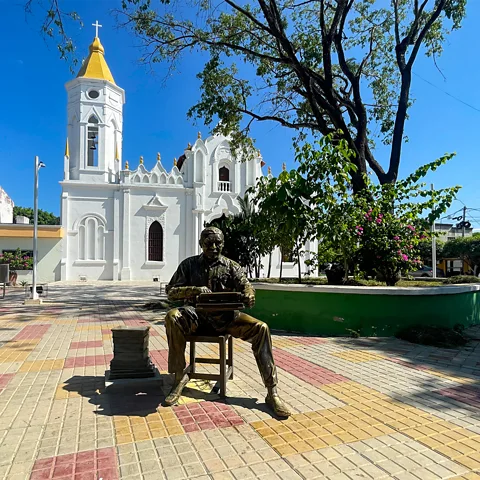 Catherine Ellis
Catherine EllisTravelling through this part of Colombia's Caribbean corner reveals vivid scenes that are reflected in the novel's blurred blend of fantasy and reality. Vast swamps, the ones that the "gypsies" navigate in the book, give way to blue waters that José Arcadio Buendía (the founder of Macondo) searches for when settling the town. Endless banana fields, like those surrounding Macondo, sweep into the towering mountain peaks of the Sierra Nevada, which the characters traverse in the beginning of the tale. Fiery-red sunsets melt into black skies glistening with stars, and the brightest of days can be erased in an instant with fierce winds and doomsday-like downpours – which can last for nearly five years in Macondo.
It's therefore easy for fans to understand what García Márquez meant when he once said: "Caribbean reality resembles the wildest imagination."
Here are the real-life places that inspired the magical realism in One Hundred Years of Solitude to come to life.
Aracataca
A little before the late-morning heat casts a hazy spell over the sleepy town of Aracataca, a smattering of tourists, guides and vendors shelter in the shade of a tree-lined street near a large white house-turned museum.
Museum guide Donal Ramos explains that García Márquez was born here in 1927 and lived here with his grandparents until he was eight years old.
"He was a very lively child, but he always came to this place and would be calmer," Ramos explains, standing in the author's grandfather's workshop. "While his grandfather made little fish, Gabo [as García Márquez was affectionally called] would draw," he adds. The gold fish inspired the ones "The Colonel" Aureliano Buendía made that he would sell for gold coins, only to turn into more fish, in the book.
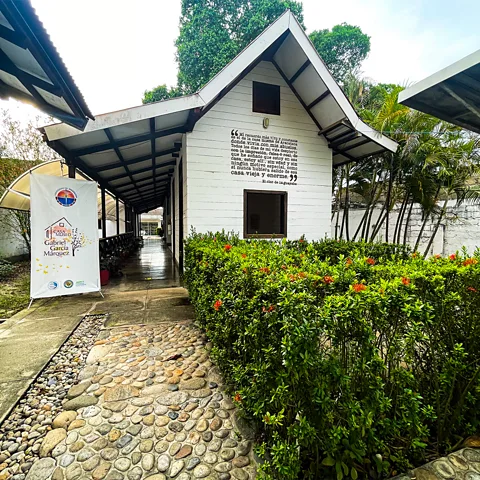 Catherine Ellis
Catherine EllisRamos ushers a small group through other rooms of the house, pausing where a young García Márquez would have slept, before moving on to the kitchen with small animal figures on sticks resting on a counter.
"This is where [García Márquez] saw his grandmother make her candied animals, just like the character, Úrsula Iguarán, did in the novel," Ramos recounts. "The novel was initially going to be named The House," Ramos reveals, because of the abundance of tales that came out of this home, "But it eventually became One Hundred Years of Solitude due to the perpetual loneliness that all the characters experienced."
Outside, the aroma of freshly brewed coffee swirls around a small stall. Its beans were grown by a local producer in the nearby Sierra Nevada mountain range that characters in the novel cross at the start of the book and the new Netflix series.
 Catherine Ellis
Catherine EllisThe stall's owner, resident Emilia Salcedo, explains her love for García Márquez's most famous work. "It's a book that's always on my nightstand. Every time I read it, I identify with it more and more," she says, explaining that she feels closest to Macondo at Aracataca's train station, when butterflies are swept away by the breeze of the long, creaking trains.
In the book the arrival of the railroad brings modernity to Macondo, and García Márquez writes that 120 train carriages carrying bananas "took a whole afternoon to pass by". In Aracataca too, the railroad once transported passengers and bananas, but today the single-track trainline only carries freight. Yet, locals still gather on its benches, watching the trains – and butterflies – disappear into in the distance.
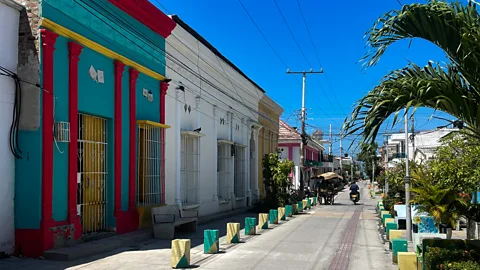 Catherine Ellis
Catherine EllisAt Aracataca's central Plaza de Simón Bolívar, women with push carts sell drinks, just as vendors do in Macondo's main square. Nearby, residents rest in doorways on what García Márquez called The Street of Turks – Macondo's main commercial hub, where Middle Eastern immigrants would sell their merchandise. When children finish school for the day, some dash off to play in the town's river, with its bed of polished stones that García Márquez wrote resembled "prehistoric eggs".
Elsewhere, businesses are named after Macondo, murals of García Márquez abound, the library and certain hotel rooms are named after characters in the novel and paintings and statues immortalise key moments in the book – such as one of Remedios the Beauty floating to heaven while hanging laundry.
Ciénaga
A 60km drive north from Aracataca, Ciénaga is an attractive town set on the salty shores of the Caribbean Sea. Its paved and cobbled streets offer a glimpse of the wealth that once flourished thanks to its huge banana exports at the start of the 20th Century. Yet, Ciénaga is used as a backdrop for a harrowing event that takes places in the latter half of the novel.
In 1928, employees at The United Fruit Company went on strike to demand better working conditions, but they were gunned down by the Colombian army. Estimates vary wildly for how many people died, but in García Márquez's retelling in Macondo, there's only one survivor. Local guide and artist Yeiner Mendoza points out a tall statue of a banana worker holding a machete at the town's former railroad station. "It's called Prometheus of Liberty," he says. "What García Márquez describes [in the novel] is what is known in Colombia as The Banana Massacre."
Later, Mendoza points across Ciénaga's elegant main square to the grand San Juán Bautista church that was damaged in a fire in 1902 during Colombia's War of a Thousand Days. "The scene is recounted in One Hundred Years of Solitude, where the church is destroyed by the Liberals and Colonel Aureliano Buendía later rebuilds it," he says.
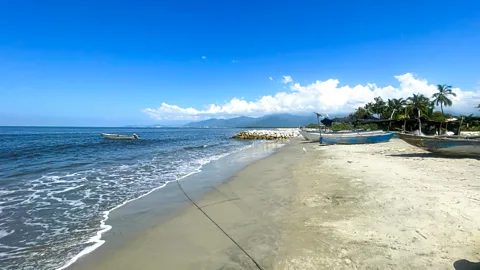 Catherine Ellis
Catherine EllisDespite its pretty colonial and Republican-style architecture, the name Ciénaga actually means "swamp". Adjacent to the town lies the Ciénaga Grande de Santa Marta, a Unesco Biosphere Reserve and the largest swamp in Colombia.
"Márquez would travel [from Ciénaga] across it towards the city of Barranquilla, at a time when the highway didn't exist," Mendoza explains. "And so, Gabriel García Márquez was able to describe so vividly what it was like crossing the 'great swamp' where the gypsy character Melquiades passed through."
Riohacha and La Guajira
Tracing the Caribbean coast, buses dip into the city of Santa Marta – the first Spanish settlement in Colombia, founded in 1525 – before continuing towards the country's northernmost tip. The region of La Guajira is home to a sanctuary of vibrant pink flamingos, blue seas, golden beaches, tawny brown desert and a carpet of shimmering salt flats with dusty pink pools.
In many ways, La Guajira is really where One Hundred Years of Solitude begins. Before the founding of Macondo, the characters in the novel leave behind their homes in La Guajira, as José Arcadio Buendía wants to flee after killing a man, and other townspeople want a fresh start. This is where García Márquez's own story starts too, as the themes of uprooting and settling in a new land are partly inspired by tales he heard growing up of his ancestors relocating from their home in La Guajira's largest city, Riohacha, to Aracataca.
 Catherine Ellis
Catherine EllisRiohacha is where García Márquez was conceived during his parents' honeymoon, and as a child, his grandmother would tell him fantastical tales about the city and La Guajira. Anthropologist and Riohacha resident, Weildler Guerra, explains that when García Márquez was a boy, he visited Riohacha with his grandparents and mother, and he later described as being like a "journey to the seed" where he borrowed and embellished details that he inserted into the novel.
Guerra says they'd talk of pirate raids and the city's devotion to Nuestra Senora de los Remedios, Riohacha's patron saint. Details of these pirate raids in Riohacha made it into the novel, and one of the story's most iconic characters is Remedios.
Riohacha is also the hometown of the priest who helped organise García Márquez's parents' marriage – and rumours circulated that he could levitate. According to Guerra, the priest inspired the character of Father Nicanor Reyna in the novel: a man who casually levitates while drinking hot chocolate.
Riohacha and La Guajira, more generally, is home to the Wayúu people, who feature prominently in One Hundred Years of Solitude – especially in the characters of Visitacíon and Cataure, who work for the Buendías. When García Márquez was living with his grandparents in Aracataca, the servants in the house were also Wayúu. García Márquez learned some words in Wayuunaiki, the Wayúu language, as a child, and two of the book's children, Aramanta and Arcadio, learn Wayuunaiki before they can speak Spanish.
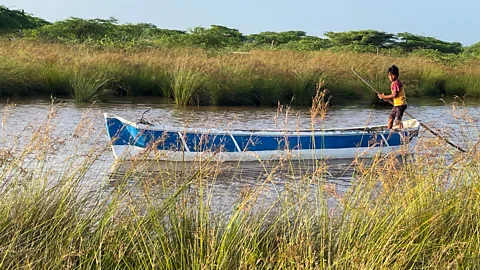 Catherine Ellis
Catherine EllisFor Guerra, who himself is Wayúu, the inclusion of Indigenous characters to the novel adds a cultural richness to the narrative that reflects the region. "Visitación and Cataure were the ones who knew about the plague of sleep and about cosmologies that were present," he says, explaining that for the Wayúu, dreams are a way of bridging spiritual world or predicting reality.
While García Márquez died in Mexico in 2014, the magic he extracted from this slice of Colombia's Caribbean will forever live on in his writing. As García Márquez once said: "The truth is that there's not a single line in all my work that does not have a basis in reality."
--
If you liked this story, sign up for The Essential List newsletter – a handpicked selection of features, videos and can't-miss news, delivered to your inbox twice a week.
